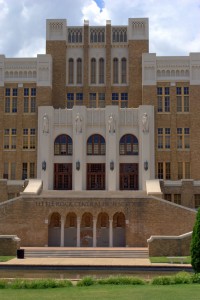Three years after the U.S. Supreme Court ruled unanimously in Brown v. Board of Education that separate educational facilities are inherently unequal, nine African American students—Minnijean Brown, Terrance Roberts, Elizabeth Eckford, Ernest Green, Thelma Mothershed, Melba Patillo, Gloria Ray, Jefferson Thomas, and Carlotta Walls—attempted to integrate Central High School in Little Rock, Arkansas.
The students, known as the Little Rock Nine, were recruited by Daisy Bates, president of the Arkansas branch of the National Association for the Advancement of Colored People (NAACP). As president of the Montgomery Improvement Association, Martin Luther King wrote President Dwight D. Eisenhower requesting a swift resolution allowing the students to attend school.
On 4 September 1957, the first day of school at Central High, a white mob gathered in front of the school, and Governor Orval Faubus deployed the Arkansas National Guard to prevent the black students from entering. In response to Faubus’ action, a team of NAACP lawyers, including Thurgood Marshall, won a federal district court injunction to prevent the governor from blocking the students’ entry. With the help of police escorts, the students successfully entered the school through a side entrance on 23 September 1957. Fearing escalating mob violence, however, the students were rushed home soon afterward.
Observing the standoff between Faubus and the federal judiciary, King sent a telegram to President Eisenhower urging him to “take a strong forthright stand in the Little Rock situation.� King told the president that if the federal government did not take a stand against the injustice it would “set the process of integration back fifty years. This is a great opportunity for you and the federal government to back up the longings and aspirations of millions of peoples of good will and make law and order a reality� (King, 9 September 1957). Aware that the Little Rock incident was becoming an international embarrassment, Eisenhower reluctantly ordered troops from the Army’s 101st Airborne Division to protect the students, who were shielded by federal troops and the Arkansas National Guard for the remainder of the school year. In a 25 September telegram, King praised the president’s actions: “I wish to express my sincere support for the stand you have taken to restore law and order in Little Rock, Arkansas. . . .You should know that the overwhelming majority of southerners, Negro and white, stand firmly behind your resolute action� (Papers 4:278).
At the end of the school year, Ernest Green became the first African American to graduate from Central High School. King attended his graduation ceremony. In honor of their momentous contributions to history and the integration of the Arkansas public school system, in 1958 the Little Rock Nine were honored with the NAACP’s highest honor, the Spingarn Medal.
Before schools opened in the fall of 1958, Faubus closed all four of Little Rock’s public high schools rather than proceed with desegregation, but his efforts were short lived. In December 1959, the Supreme Court ruled that the school board must reopen the schools and resume the process of desegregating the city’s schools.
